
Aglyptodactylus is a genus of frogs in the family Mantellidae. These frogs, sometimes known as the Madagascar jumping frogs, are endemic to Madagascar. Systematic revisions of the groups were published in 1998 and 2015. Six species are currently recognized.
Boophis blommersae is a species of frog in the family Mantellidae. It is endemic to northern Madagascar and is known from two locations, Montagne d'Ambre and the vicinity of Tsaratanana. There is also a recent from near Bemanevika. The specific name blommersae honours Rose Marie Antoinette Blommers-Schlösser, a Dutch herpetologist and entomologist.
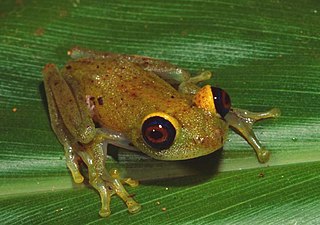
The green bright-eyed frog is a species of frog in the family Mantellidae. It is endemic to Madagascar.

Mantidactylus albofrenatus is a species of frog in the family Mantellidae. It is endemic to eastern Madagascar near An'Ala and Andasibe. Common name eastern Madagascar frog has been proposed for it.

Mantidactylus betsileanus is a species of frog in the family Mantellidae. It is endemic to Madagascar. Its natural habitats are subtropical or tropical moist lowland forests, subtropical or tropical moist montane forests, rivers, freshwater marshes, intermittent freshwater marshes, arable land, rural gardens, heavily degraded former forest, and seasonally flooded agricultural land.
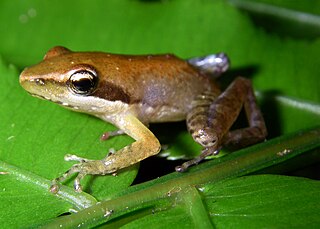
Blommersia blommersae is a species of frog in the family Mantellidae. It is endemic to east-central Madagascar. Both the generic and specific names honour Rose Marie Antoinette Blommers-Schlösser, a Dutch herpetologist and entomologist who collected the type series. Common name Moramanga Madagascar frog has been proposed for it.

Mantidactylus femoralis is a species of frog in the family Mantellidae. It is endemic to Madagascar. It is a complex of multiple species. Its natural habitats are subtropical or tropical moist lowland forests, subtropical or tropical moist montane forests, subtropical or tropical high-altitude shrubland, rivers, and heavily degraded former forest. It is threatened by habitat loss.
Wakea madinika is a species of frogs in the mantellid subfamily Mantellinae. It is the only species in the monotypic genus Wakea. It is endemic to Madagascar.

Mantidactylus majori is a species of frog in the family Mantellidae. It is endemic to Madagascar. Its natural habitats are subtropical or tropical moist lowland forests, subtropical or tropical moist montane forests, rivers, and swamps. It is threatened by habitat loss.
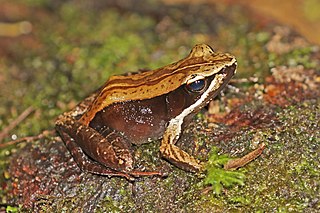
Mantidactylus melanopleura is a species of frog in the family Mantellidae. It is endemic to Madagascar. Its natural habitats are subtropical or tropical moist lowland forests and rivers. It is threatened by habitat loss.

Boehmantis is a genus of frogs in the mantellid subfamily Mantellinae. It is monotypic, being represented by a single species, Boehmantis microtympanum. The genus is endemic to Madagascar.
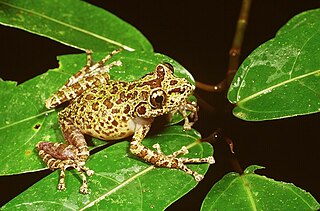
Spinomantis peraccae is a species of frog in the mantellid subfamily Mantellinae. It is endemic to Madagascar and widely distributed in the northern, eastern, and central parts of the island. The specific epithet honours Italian herpetologist Mario Giacinto Peracca. Common name Peracca's Madagascar frog has been coined for it.
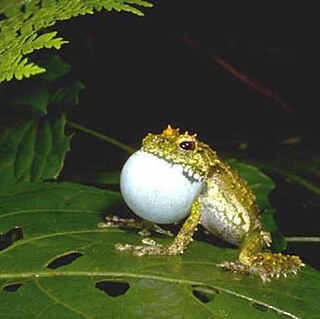
Spinomantis phantasticus is a species of frog in the family Mantellidae. It is endemic to east-central and northeastern Madagascar.

Gephyromantis tschenki, commonly known as Tschenk's Madagascar frog, is a species of frogs in the family Mantellidae. It is endemic to Madagascar. Its natural habitats are subtropical or tropical moist lowland forests, subtropical or tropical moist montane forests, and rivers. It is threatened by habitat loss.

Mantidactylus zipperi is a species of frog in the family Mantellidae. It is endemic to Madagascar. Its natural habitat is pristine or only slightly disturbed rainforest. It is usually found near streams. It is threatened by habitat loss.
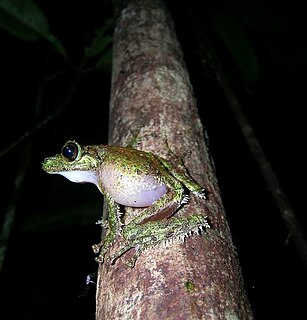
Spinomantis is a frog genus in the mantellid subfamily Mantellinae. This genus is restricted to Madagascar. At present it contains 13 species. They are arboreal or terrestrial frogs and occur in or along small streams. Most species are nocturnal.
Boophis baetkei is a species of frog in the family Mantellidae. It is endemic to northern Madagascar and only known from its type locality on the eastern edge of the Fôret d'Ambre Special Reserve in the Antsiranana Province. It is an arboreal species that was found in a heavily disturbed transitional forest. It is threatened by severe habitat loss occurring in the area of its type locality.
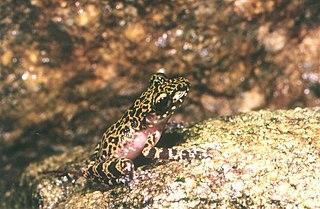
Spinomantis brunae is a species of frogs in the family Mantellidae. It is endemic to Madagascar and known from the Anosy Mountains in southeastern Madagascar.

Spinomantis massi is a species of frog in the mantellid subfamily Mantellinae. It is endemic to the humid forests of northwestern Madagascar.
Mantidactylus radaka is a species of frog in the family Mantellidae. It is endemic to Madagascar. It was described in 2020 by an international team of scientists, who differentiated it from M. guttulatus and M. grandidieri via molecular data from wild and museum specimens.

















